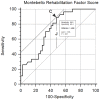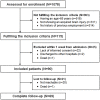Return to Work: A Cut-Off of FIM Gain with Montebello Rehabilitation Factor Score in Order to Identify Predictive Factors in Subjects with Acquired Brain Injury
- PMID: 27780215
- PMCID: PMC5079591
- DOI: 10.1371/journal.pone.0165165
Return to Work: A Cut-Off of FIM Gain with Montebello Rehabilitation Factor Score in Order to Identify Predictive Factors in Subjects with Acquired Brain Injury
Abstract
Return to work (RTW) for people with acquired brain injury (ABI) represents a main objective of rehabilitation: this work presents a strong correlation between personal well-being and quality of life. The aim of this study is to investigate the prognostic factors that can predict RTW after ABI (traumatic or non- traumatic aetiology) in patients without disorders of consciousness (e.g. coma, vegetative or minimally conscious state) at the beginning of their admission to rehabilitation. At the end of a 6-month follow-up after discharge, data were successfully collected in 69 patients. The rehabilitation effectiveness (functional Recovery) between admission and discharge was assessed by Functional Independent Measure (FIM) gain, through the Montebello Rehabilitation Factor Score (MRFS), which was obtained as follows: (discharge FIM-admission FIM)/(Maximum possible FIM-Admission FIM) x 100. The cut-off value (criterion) deriving from MRFS, which helped identify RTW patients, resulted in .659 (sn 88.9%; sp 52.4%). Considering the Mini Mental State Examination (MMSE) and the MRFS data, the multivariable binary logistic regression analysis presented 62.96% of correct RTW classification cases, 80.95% of non-RTW leading to an overall satisfactory predictability of 73.91%. The results of the present study suggest that occupational therapy intervention could modify cut-off in patients with an MFRS close to target at the end of an in-hospital rehabilitative program thus developing their capabilities and consequently surpassing cut-off itself.
Conflict of interest statement
The authors have declared that no competing interests exist.
Figures



Similar articles
-
Natural history of recovery from brain injury after prolonged disorders of consciousness: outcome of patients admitted to inpatient rehabilitation with 1-4 year follow-up.Prog Brain Res. 2009;177:73-88. doi: 10.1016/S0079-6123(09)17707-5. Prog Brain Res. 2009. PMID: 19818896
-
Who among patients with acquired brain injury returned to work after occupational rehabilitation? The rapid-return-to-work-cohort-study.Disabil Rehabil. 2018 Oct;40(21):2561-2570. doi: 10.1080/09638288.2017.1354234. Epub 2017 Jul 20. Disabil Rehabil. 2018. PMID: 28724317
-
Occupational categories and return to work after traumatic brain injury: a multicenter study.Arch Phys Med Rehabil. 2006 Dec;87(12):1576-82. doi: 10.1016/j.apmr.2006.08.335. Arch Phys Med Rehabil. 2006. PMID: 17141636
-
Functional level during the first 2 years after moderate and severe traumatic brain injury.Brain Inj. 2015;29(12):1431-8. doi: 10.3109/02699052.2015.1063692. Epub 2015 Sep 11. Brain Inj. 2015. PMID: 26361939
-
Return to work following traumatic brain injury: trends and challenges.Disabil Rehabil. 2007 Sep 15;29(17):1387-95. doi: 10.1080/09638280701315011. Disabil Rehabil. 2007. PMID: 17729084 Review.
Cited by
-
Factors influencing return to work after stroke: the Korean Stroke Cohort for Functioning and Rehabilitation (KOSCO) Study.BMJ Open. 2019 Jul 11;9(7):e028673. doi: 10.1136/bmjopen-2018-028673. BMJ Open. 2019. PMID: 31300502 Free PMC article.
-
Longitudinal Genome-Wide Association Study of Cognitive Impairment after Subarachnoid Hemorrhage.Biomedicines. 2024 Jun 22;12(7):1387. doi: 10.3390/biomedicines12071387. Biomedicines. 2024. PMID: 39061961 Free PMC article.
-
Predictive value of a self-administered frailty screening questionnaire for the effectiveness of functional rehabilitation evaluated with the locomotor functional independence measure in a geriatric rehabilitation unit: a multicentre cohort study.BMC Geriatr. 2024 Dec 19;24(1):1013. doi: 10.1186/s12877-024-05605-x. BMC Geriatr. 2024. PMID: 39702184 Free PMC article.
References
MeSH terms
LinkOut - more resources
Full Text Sources
Other Literature Sources

